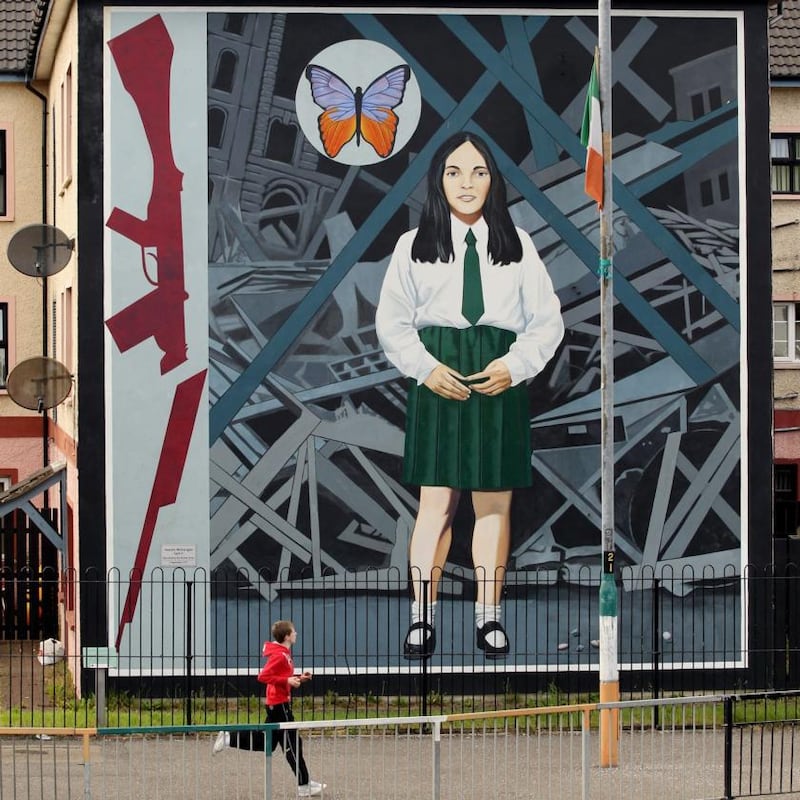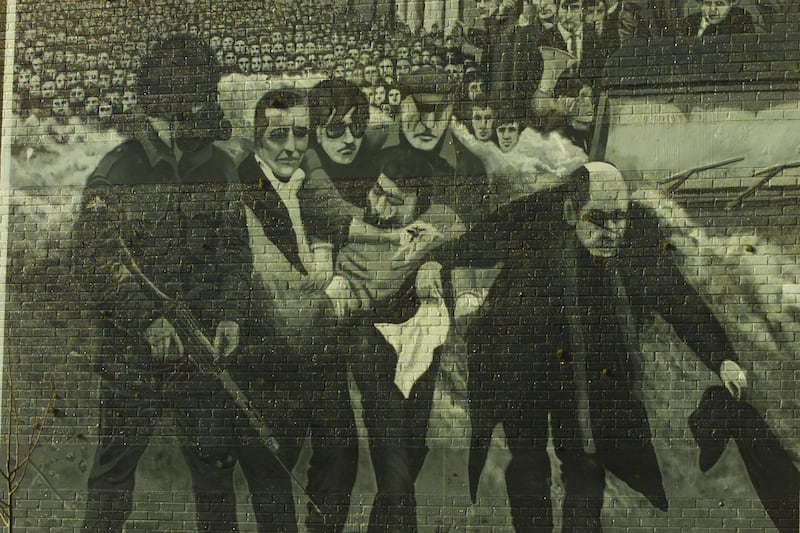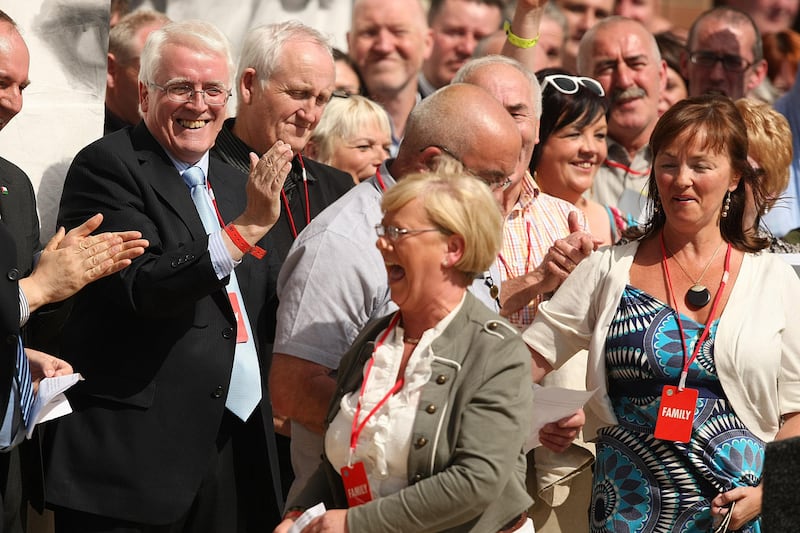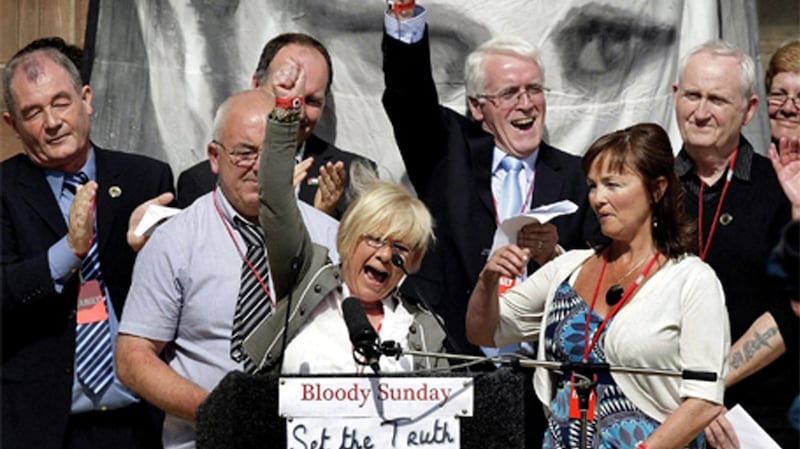Bloody Sunday happened twice.
The first time, on January 30th, 1972, it was a real event: a massacre in Derry of 13 unarmed civilians by the first battalion of the British army’s Parachute Regiment.
The second time, three months later, it was a toxic fiction: an official British government report in plain blue covers by "The Rt Hon Lord Widgery OBE TD". The "TD" stood for Territorial Decoration, a military medal awarded for long service as an officer in the British army reserve.
Widgery pontificated that while some of the firing by the Paras may have “bordered on the reckless”, the soldiers were returning fire in a gun battle. He was, evidently to his chagrin, unable to show that any of the 13 people killed and at least 15 wounded (one of them mortally) was engaged in attacking the Paras, but expressed a “strong suspicion that some… had been firing weapons or handling bombs in the course of the afternoon and that yet others had been closely supporting them”. All of this was pure fabrication.
The first Bloody Sunday, the real one, was a moral and human disaster. The second one, the British Establishment’s fictionalised and slanderous version, was a political disaster.
It destroyed for a long time any hope that the British government could be seen by Irish nationalists as an honest broker. It deepened the abyss into which Northern Ireland was tumbling and made the task of climbing out of it much more difficult. Far more people died because of Bloody Sunday than those who were murdered on the day.

The British army had been on the streets of Derry since August 1969. It was initially welcomed as a line of defence for Catholic communities against Protestant mobs, a force likely to be more neutral than the local Protestant-dominated Royal Ulster Constabulary and especially its notoriously sectarian B-Specials. "We cheered the soldiers and jeered the cops," remembered the brilliant journalist and activist in the Bogside, heartland of Catholic Derry, Nell McCafferty.
But by the beginning of 1972, the Bogside had long ceased cheering the soldiers. As part of what McCafferty called a “scorched earth policy” on the part of militant nationalists, much of the city west of the Foyle lay in ruins.
The Provisional IRA’s campaign of destruction left it looking, as Eamonn McCann put it, as though it had been bombed from the air. Most of this pockmarked terrain had become a no-go area for the RUC, and even the army entered it only in large units.
In August 1971, the unionist administration at Stormont had introduced internment without trial (used exclusively at first against Catholics, most of them not involved in the IRA) and, at the same time, a ban on marches and demonstrations. Both of these issues were at play on Bloody Sunday: the Northern Ireland Civil Rights Association decided to defy the ban in order to stage a protest against internment.
The most senior police officer in Derry, Chief Superintendent Frank Lagan, recommended that the march be allowed to proceed. The authorities decided to allow it pass through the nationalist areas of the city, but to stop it from reaching its intended destination, the Guildhall. This would be done by erecting barriers manned by armed troops.
At the beginning of the month, Maj Gen Robert Ford, then commander of Land Forces in Northern Ireland, had expressed internally the view that the only way to stop further destruction of the city was, “after clear warnings, to shoot selected ringleaders”. This was not a mandate for what was to happen on January 30th, but it does suggest a drift within the highest echelons of the army towards a trigger-happy attitude.
This unit had not only developed a taste for atrocity, it had very recent experience of total impunity
What Ford did want to do in Derry on Bloody Sunday, though, was to respond with force to the riots he expected to follow the blocking of the march. He saw this as an opportunity to move in and arrest what he regarded as “ringleaders” of those the army referred to as the Derry Young Hooligans.
He had a very specific strike force in mind. Ford moved the gung-ho first battalion of the Parachute Regiment (1 Para) from its base outside Belfast into Derry. It arrived on the morning of Bloody Sunday, under the command of Lieut Col Derek Wilford.
This unit already had innocent civilian blood on its hands. In August 1971, over a period of 36 hours in Ballymurphy, a small Catholic housing estate in west Belfast, 10 innocent civilians were shot dead. Nine of them were almost certainly killed by members of 1 Para.
As would happen after Bloody Sunday, these victims were traduced as terrorists who were attacking the soldiers. This unit had not only developed a taste for atrocity, it had very recent experience of total impunity.
The organisers of the Derry march decided to avoid a possible confrontation with the army and rerouted the march so that the rally would be at Free Derry Corner in the Bogside rather than at the Guildhall.
But a large number of marchers decided in fact to continue along the original route towards one of the main army barriers. Some of them began to throw stones at the soldiers. Rioting also broke out at two other barriers.

There was, by this stage in the city’s Troubles, nothing especially remarkable in these confrontations. The army had well-established ways of responding – with CS gas, baton rounds and water cannon – and these were indeed deployed by one of the regiments involved, the Green Jackets.
There was no reason whatsoever for the Paras to open fire with live rounds. But at approximately four o’clock, two of them fired five shots at a 15-year-old boy, Damien Donaghy, wounding him in the thigh. This was the first blood of Bloody Sunday.
Wilford then took the decision, apparently off his own bat, to send a platoon of his Paras out beyond the barriers into the Bogside, where the peaceful marchers had gone. This meant that the whole supposed justification of the operation – the arrest of rioters – evaporated.
The Paras opened fire indiscriminately on people in the area of Rossville Flats car park. This was where the first mortal casualty, 17 year-old Jackie Duddy, was killed. Another seven people were wounded.
Another platoon arrived in the Bogside and started firing, killing another 17 year old, Michael Kelly. While he was being carried away, they shot and killed five others: Hugh Gilmour (17), William Nash (19), John Young (17), Michael McDaid (20) and Kevin McElhinney (17).
The Paras moved on into Glenfada Park and mowed down six more people, killing two of them. One of them, Jim Wray (22), was finished off with a second shot as he lay on the ground. The murderous intent could not be clearer.
A lone soldier, presumably on his own initiative, then moved into Abbey Park and managed to kill two men, Gerard McKinney (35) and Gerald Donaghy (17), with a single shot. Others began firing across Rossville Street, killing Bernard McGuigan (41) and mortally wounding Paddy Doherty (32).
Almost half of the fatalities were, technically and legally, children. Deliberately or otherwise, the soldiers targeted boys who would never get to become men
This killing spree in the Bogside took barely more than 10 minutes. Over that time, the Paras fired more than 100 bullets at defenceless people. They could in principle have killed 100 civilians.
Conversely, no soldier was hurt, let alone killed, by gunfire or by nail bombs or other explosives. Two of them were slightly injured by some corrosive substance that somebody threw at them from a balcony of the Rossville Flats. That was the height of the threat they faced. As the report of the exhaustive Saville inquiry report put it in 2010: “none of the casualties was posing a threat of causing death or serious injury, or indeed was doing anything else that could in any view justify their shooting”.
It is worth noting that almost half of the fatalities were, technically and legally, children. Deliberately or otherwise, the soldiers targeted boys who would never get to become men.
Perhaps this is one of the reasons why, even in a place that had already experienced a great deal of violence, the sight of those bodies was unbearable. Many of those present were later haunted by the fact that, in a deeply Catholic culture, they did not stop to pray for and be with the dead and dying. They moved numbly away, unable to process the horror.
Yet, the British authorities knew very well how to process it. There was an established narrative they could tap into: soldiers in fear of their lives protecting themselves against snipers and nail bombers.

But even more than that, there was an instinct of ruling class solidarity. It is interesting to think about the Widgery report in relation, for example, to the way the Establishment dealt with the victims of the Hillsborough football ground disaster in England in 1989.
The events were radically different, except in the fact that a lot of working class people died as a result of the recklessness of the authorities. But the basic response was the same: blame the victims, blacken their names, exonerate the guilty, close ranks.
In England, that way of dealing with a deadly disaster created by the authorities themselves was devastating. But in the context of the Troubles it was what the Saville inquiry, breaking with the conventions of legalistic language, rightly called “a catastrophe”.
Bloody Sunday discredited the British state, but it also cut the ground from under the large majority of Irish Catholics and nationalists who believed in forcing change through protest and civil disobedience.
The truth is that those methods were in fact successful; by the end of 1972, the Orange State was gone. The unionist monolith would never return to power.
A pattern of answering outrage with outrage, atrocity with atrocity, was established and it would hold its shape for more than 20 years
But the combination of atrocity and cover-up, of crude savagery and suave cynicism in the Bloody Sunday story, gave credence to a counter-narrative of war to the death. It was all too easy to lose patience with the unavoidable political complexities of Northern Ireland and to revert to an atavistic logic: kill them before they kill us.
In this warped logic, the answer to the murders of innocent civilians was the murder of innocent civilians. The Official IRA’s retaliation for Bloody Sunday was to place a bomb in the Parachute Regiment’s barracks at Aldershot that killed five female cleaners, a gardener and the Catholic chaplain.

The Provisional IRA’s reply was Bloody Friday, when it detonated 19 bombs in the centre of Belfast. About 130 people were injured, many of them maimed for life, and nine died. Two of them – William Crothers and Stephen Parker – were children.
A pattern of answering outrage with outrage, atrocity with atrocity, was established and it would hold its shape for more than 20 years. Not the least of the obscenities was that within this deadening repetition, Bloody Sunday would acquire the prefix that became a warrant for inhumanity: what about.
“What about Bloody Sunday?” should never have been a way of evading the truth of what happens when armies, public or private, feel free to turn their nihilistic power on defenceless people. It should always be a reminder that this truth must be faced as much by self-righteous democracies as by those they purport to despise.















